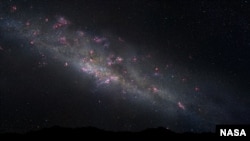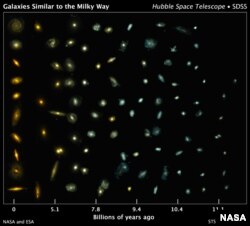The U.S. space agency, NASA, released a series of photos that show how our galaxy, the Milky Way, may have evolved.
Astronomers used Hubble's deep-sky surveys to study the evolution of 400 galaxies similar to the Milky Way and noted their appearance at various stages of development over a time span of 11 billion years.
Judging from images of these far-flung galaxies, they found the Milky Way likely began as faint, blue, low-mass object containing lots of gas. Gas is the fuel for star birth and the blue color is an indicator of rapid star formation. It was probably a flat disk with a bulge in the middle, both of which grew simultaneously into the majestic spiral seen today.
"For the first time, we have direct images of what the Milky Way looked like in the past," said study co-leader Pieter G. van Dokkum of Yale University in New Haven, Conn. "Of course, we can't see the Milky Way itself in the past. We selected galaxies billions of light-years away that will evolve into galaxies like the Milky Way. By tracing the Milky Way's siblings, we find that our galaxy built up 90 percent of its stars between 11 billion and 7 billion years ago, which is something that has not been measured directly before."
The team's results were published July 10 in The Astrophysical Journal Letters. A second paper appears in the Nov. 11 online edition of The Astrophysical Journal.
Astronomers used Hubble's deep-sky surveys to study the evolution of 400 galaxies similar to the Milky Way and noted their appearance at various stages of development over a time span of 11 billion years.
Judging from images of these far-flung galaxies, they found the Milky Way likely began as faint, blue, low-mass object containing lots of gas. Gas is the fuel for star birth and the blue color is an indicator of rapid star formation. It was probably a flat disk with a bulge in the middle, both of which grew simultaneously into the majestic spiral seen today.
"For the first time, we have direct images of what the Milky Way looked like in the past," said study co-leader Pieter G. van Dokkum of Yale University in New Haven, Conn. "Of course, we can't see the Milky Way itself in the past. We selected galaxies billions of light-years away that will evolve into galaxies like the Milky Way. By tracing the Milky Way's siblings, we find that our galaxy built up 90 percent of its stars between 11 billion and 7 billion years ago, which is something that has not been measured directly before."
The team's results were published July 10 in The Astrophysical Journal Letters. A second paper appears in the Nov. 11 online edition of The Astrophysical Journal.










